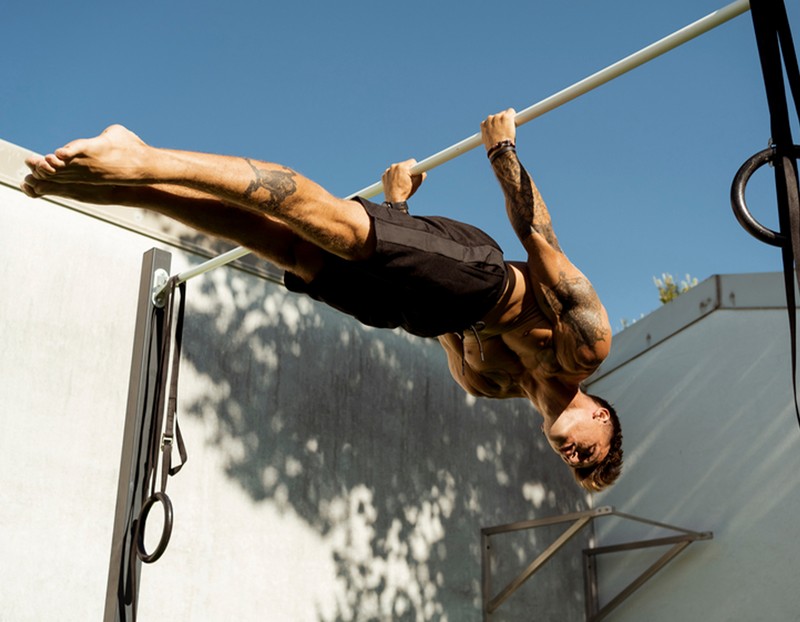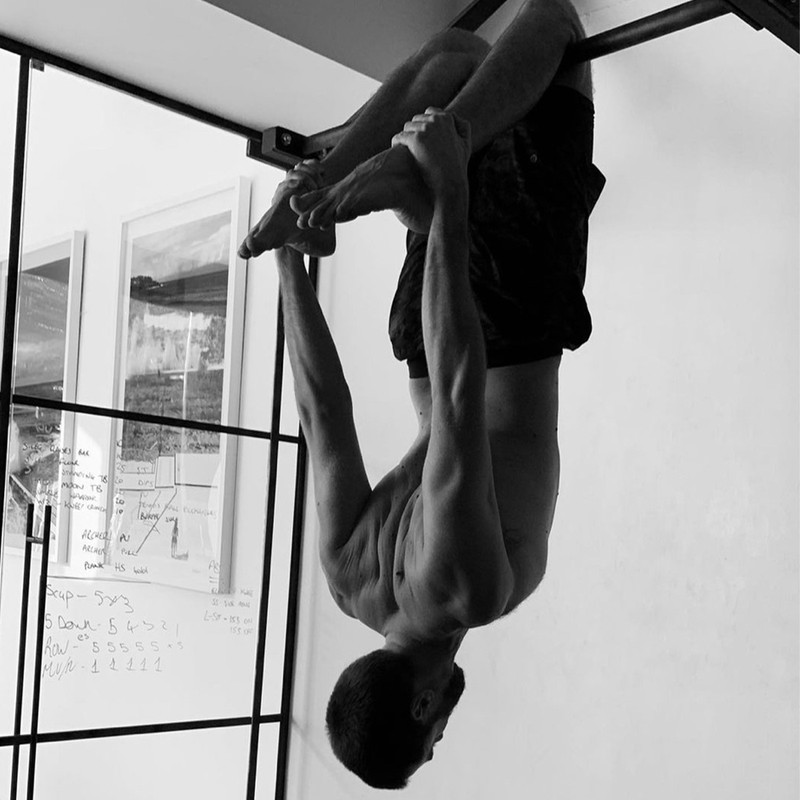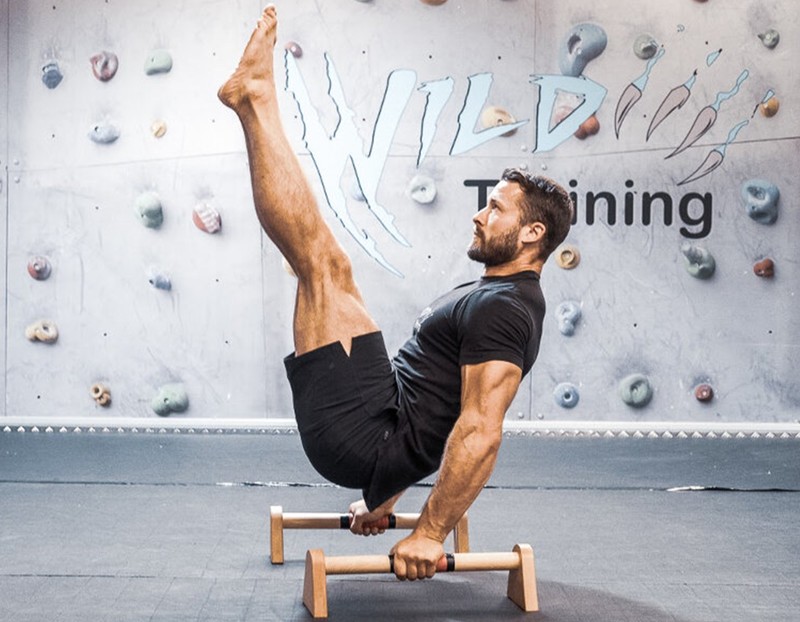A Pro Guide To Calisthenics
Harry Aitken
Master Trainer At Auster Fitness, says…
It’s a supercharged form of strength training
Calisthenics is an umbrella term for strength training that uses bodyweight and minimal external equipment. That’s pushing, pulling, balancing, jumping, bending and swinging which, depending on how it’s done, can lead to increased strength, fitness, balance and flexibility. In calisthenics, you use your body as weight, rather than a barbell, dumbbell or machine, and use angles and body position to make exercises harder or easier. So, rather than adding weight, you can change your body position as you get stronger, or advance to the next progression of an exercise.
There are two ways to build strength
The USP of calisthenics is that it can be done anywhere, with no equipment. There are two main forms of exercises that build strength – the bent arm (dynamic exercises) and straight arm (static exercises). Dynamic exercises are often performed for reps, while static exercises tend to be performed for time, holding a specific position. Static holds are seen as skills – the most well-known is the headstand. One of the best things about calisthenics is that you go from not being able to perform an exercise to being able to perform it. This isn’t the case with strength training, when you can perform a move from the get-go, albeit with a lighter weight. However, this also means that it’s trickier to gauge progress in calisthenics, as the progressions are far less obvious than simply picking up a heavier dumbbell.
It’s a mindful way to workout
Calisthenics will help you build an incredible physique – look at Olympic gymnasts – but it’s less known that it can also help build a strong mind-muscle connection and body control. The need to focus on specific movements, progressions and regressions means you must learn how to activate and target specific muscle groups. It’s also a seriously rewarding workout – mastering a handstand is a pretty great feeling.
Start with the basics
The most common mistake beginners make is performing exercises with poor form. Start with press-ups, rows and squats, and progress to pull-ups and dips. Start with some simple holds like hollow body holds, or a support hold. Ensure your form is spot on before building up the reps. Using a resistance band can make an exercise easier. If you’re struggling with a pull-up, place a resistance band over the bar and loop your feet into it so it supports you. Similarly, if you can’t do a press-up, try looping the band over the bar and then placing the band on your waist so it pulls your body up as you do the press-up.
Know your scapula
Your shoulder blades (scapula) have four positions: protraction, retraction, elevation and depression. Even people who can do the advanced skills often don’t have a clue which position they’re using. Take the perfect pull-up, for example, which is a calisthenics staple. Most people protract their shoulders, which doesn’t engage the back well. The scapula must be retracted throughout the movement. Ensure your chest is proud, shoulders are pulled back, and lower back is slightly arched to maximise lat, trap and rhomboid engagement.
Visit AusterFit.com and follow @MasterAitken

James Griffiths
PT And Founder Of Wild Training, Says…
It’ll challenge the body in several ways
Calisthenics is all about challenging your strength through a variety of bodyweight exercises and skills. For me, the biggest benefit is that you learn to build tension throughout your body, which means you’ll be in better control for all sorts of activities. From an aesthetic perspective, you really see your body shape change as you hit synergistic muscles that traditional exercises don’t challenge. Some of it is about holding static positions; at other times you’ll be linking movements together to create a sequence. In the long run, you’ll build serious strength with less stress on the body in terms of recovery than heavier weightlifting.
It’s not all about strength
The biggest challenge when you’re moving your own body isn’t always your strength, it’s your flexibility. Calisthenics will help you develop your mobility and strength in greater ranges of movement, as well as your co-ordination skills. These bodyweight skills require various muscles to work together.
Visit WildTraining.co.uk
Ashton Sheriff
Calisthenics Influencer, Says…
Learn the gateway skills
Most guys start calisthenics because they want to learn impressive skills – the human flag and the muscle-up being a couple. This is definitely what drew me in. If you’re new, your first major goal should be to get comfortable with the three fundamental exercises: push-ups, pull-ups and tricep dips. These are the gateway skills that will help you unlock every single other calisthenics skill. Once you master these, you’ll be ready to start learning progressions for more advanced skills. Just be patient, as skills take a while to learn. It only makes the victory sweeter when you finally unlock a skill you’ve always dreamed of doing.
Everyone wants to master the muscle-up
The muscle-up is one of the fundamental strength exercises in calisthenics. My number one tip is to make sure you can do ten pull ups easily before progressing. Once you can do that, you should be able to perform at least one explosive pull up (i.e. a pull up that’s performed with such power that your lower chest clears the bar). When you can do this, you’ll be ready to train for the muscle-up.
Do it in the gym or outdoors
Before it became known as calisthenics, it was often referred to as a ‘street workout’ because guys would usually train in an urban workout area. If you want to find a calisthenics spot near you, type the name of your location into Google along with ‘workout park’ and a bunch of places will come up. Alternatively, there are studios that focus on calisthenics – Brixton Street Gym is great, as is PNP Fitness Studio in Hammersmith.
Follow @Ashton_Fitness_Official and check him out on YouTube and Numan.com
Paddy Archer
Founder Of CaliFlow, Says…
Take a fresh approach
If you’re a regular gym goer, you’ll need to rethink how you approach strength training. Calisthenics are compound movements, which make traditional bodybuilding moves obsolete. The traditional chin-up, for example, works your biceps, back and shoulders. The best way to structure your new routine is to mix things up: try dips, handstands and push-ups one day then chin-ups and rows the next. At CaliFlow, we offer different workouts: CaliStrength to build strong, lean bodies, CaliFlow to aid flexibility and CaliCircuit to work the full body and allow the body to move in a cohesive way.
Learn how to hang
Not everything you do to get stronger has to be complicated. In fact, it’s incredible how many of us find it challenging to simply hang when once it was second nature to us. Think of how few times in your day you raise your arms – and for most of us after a few seconds of hanging our arms will start to burn. Hanging can be used to decompress the spine and alleviate pressure created throughout the day. Mastering the art of hanging can not only help you progress to other calisthenics moves but will improve the health of your nerves. You’ll see benefits from hanging for just 60 seconds twice per day.
Visit CaliFlow.co and follow @CaliFlowPaddy
DISCLAIMER: Features published by SLMan are not intended to treat, diagnose, cure or prevent any disease. Always seek the advice of your GP or another qualified healthcare provider for any questions you have regarding a medical condition, and before undertaking any diet, exercise or other health-related programme.
DISCLAIMER: We endeavour to always credit the correct original source of every image we use. If you think a credit may be incorrect, please contact us at [email protected].



